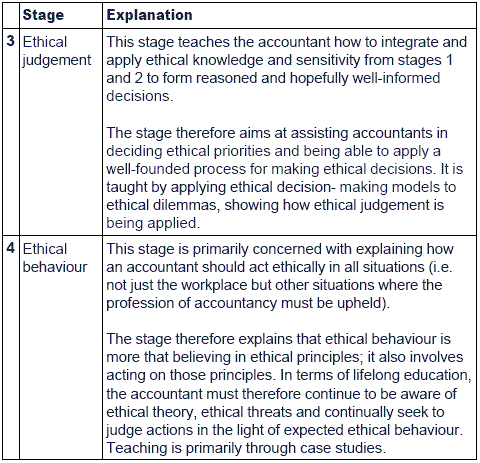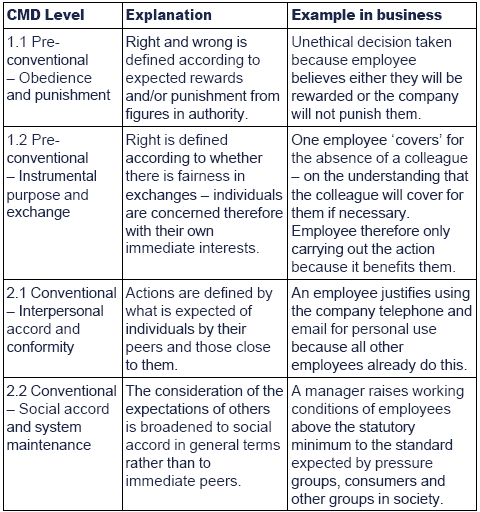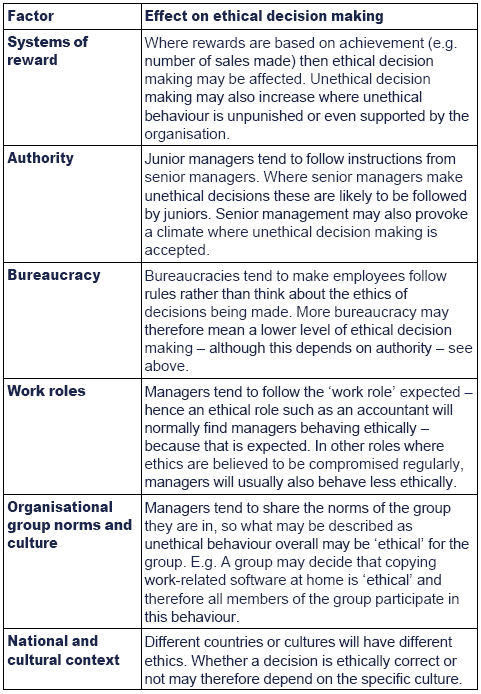Chapter 14: Ethical decision making
Chapter learning objectives
Upon completion of this chapter you will be able to:
- apply commonly used ethical decision-making models in accounting and professional contexts: (i) American Accounting Association model and (ii) Tucker's 5-question model
- explain and analyse the content and nature of ethical decision making using elements of Kohlberg's framework as appropriate
- explain and analyse issues related to the application of ethical behaviour in a professional context.
1 Ethical decision making
- Ethical decision making models are used in ethics education to provide a framework for ethical decision making.
- The main reference in this section is to the International Accounting Education Standards Board (IAESB) where a framework for ethical decision making is developed (known as the Ethics Education Framework (EEF)) and then applied using two models in the study guide.

 IAESB ethics framework
IAESB ethics framework
The IAESB Ethics Education Framework (EEF) shown above is designed to provide a structure for the development of ethical education. It recognises that ethics education is actually a lifelong process and will continue through the career of an accountant or any other professional. The framework establishes a four-stage learning continuum which professionals will generally move through during their careers.
This framework can then be applied to ethical decision making using the two models mentioned in the study guide.



- The American Accounting Association model provides a series of questions regarding the application of ethics.
- The Tucker model provides a brief framework for considering whether or not a decision is ethical.
 Refer to the Examiner's article published in Student Accountant in March 2008 "Ethical decision makingâ€
Refer to the Examiner's article published in Student Accountant in March 2008 "Ethical decision makingâ€
 American Accounting Association (AAA) model
American Accounting Association (AAA) model
The American Accounting Association model provides a framework within which an ethical decision can be made.
The seven question in the model are:
(1)What are the facts of the case?
(2)What are the ethical issues in the case?
(3)What are the norms, principles and values related to the case?
(4)What are the alternative courses of action?
(5)What is the best course of action that is consistent with the norms, principles and values identified in step 3?
(6)What are the consequences of each possible course of action?
(7)What is the decision?

 AAA model
AAA model
(1)Establishing the facts of the case. This step means that when the decision-making process starts, there is no ambiguity about what is under consideration.
(2)Identify the ethical issues in the case. This involves examining the facts of the case and asking what ethical issues are at stake.
(3)An identification of the norms, principles, and values related to the case. This involves placing the decision in its social, ethical, and, in some cases, professional behaviour context. In this last context, professional codes of ethics or the social expectations of the profession are taken to be the norms, principles, and values. For example, if stock market rules are involved in the decision, then these will be a relevant factor to consider in this step.
(4)Each alternative course of action is identified. This involves stating each one, without consideration of the norms, principles, and values identified in Step 3, in order to ensure that each outcome is considered, however appropriate or inappropriate that outcome might be.
(5)The norms, principles, and values identified in Step 3 are overlaid on to the options identified in Step 4. When this is done, it should be possible to see which options accord with the norms and which do not.
(6)The consequences of the outcomes are considered. Again, the purpose of the model is to make the implications of each outcome unambiguous so that the final decision is made in full knowledge and recognition of each one.
(7)The decision is taken.

 Tucker's 5-question model
Tucker's 5-question model
Tucker provides a 5-question model against which ethical decisions can be tested. It is therefore used after the AAA model shown above to ensure that the decision reached is 'correct'. Is the decision:
- Profitable?
- Legal?
- Fair?
- Right?
- Sustainable or environmentally sound?

 Test your understanding 1
Test your understanding 1
(Scenario expanded from TYU in chapter 12)
A global environmental group has entered into an alliance with a refrigerator manufacturer. Its actions have led to a bitter internal battle, with many founding members suggesting the organisation had 'sold out' to the business world. Others argued that their actions might help save the planet from climate change.
The company in question is FN, a German domestic and industrial refrigerator manufacture that was in receivership, its predicament arising from a lack of investment and chronic inefficiency as an ex-eastern German communist organisation. The environmental group intended to use this company to launch its Chlorofluorocarbon (CFC) -free fast-freeze unit. This revolutionary technology eliminates the emissions associated with refrigeration units that have been blamed for destroying the ozone layer and raising world climate.
The environmental group actively promoted the idea amongst its worldwide membership and, at a press conference three years ago, stated that it had a large number of advance orders from customers willing to sign up to buy the fridges once they were in production. The receiver subsequently conceded and allowed the company to begin trading again, although confidentially he believed the idea was just an attempt by the company to save themselves from receivership, rather than indicating genuine environmental beliefs.
The receiver was not the only one with reservations. Chemical companies that currently supply the CFC chemicals to the industry said the new technology was untried and would not work. Competitor refrigeration manufacturers (some of the largest companies in the world) went a step further and said the proposed fridges amounted to “a potential danger to consumers†and would not consider using the new technology.
Last year the German government signed off the prototype fridges as meeting all product safety requirements. Production began shortly afterwards, and within a year sales exceeded a quarter of a million units. Yesterday, the world's largest refrigerator manufacture announced it would be switching to the new technology within two years.
Required:
Describe the ethical decision making process of FN using Tucker's model.

2 Stages of ethical decision making
Ethical decision making involves:
- a 4-stage process
- is influenced by individual and situational factors
- can be applied to Kohlberg's CMD theory (chapter 13) in terms of business decision making.
The four stages of ethical decision making can be summarised as follows:
The model distinguishes between
- knowing what is the correct thing to do (recognising the moral issue) and
- the actual action taken (the moral behaviour – or lack of it).
So the salesperson could still lie about the cars being sold even though this had been recognised as immoral behaviour.
Factors influencing the moral decision:
The actual moral decision taken will depend on:
- Individual factors: unique characteristics of the individual making the decision such as age, gender, and experience acquired during life.
- Situational factors: particular factors in the decision area that cause an individual to make an ethical or unethical decision.

 Ethical decision making
Ethical decision making
The individual and situational factors in the ethical decision-making process fit well with the Kohlberg theory described in an earlier chapter.
A summary of the theory is repeated here for convenience.
The actual moral decision taken will depend on:
- Individual factors: unique characteristics of the individual making the decision such as age, gender, and experience acquired during life.
- Situational factors: particular factors in the decision area that cause an individual to make an ethical or unethical decision.


The 'Example in business' column shows that:
- Individual factors become more important in the higher-level decisions. The decision maker is making ethical decisions because they themselves believe that is the correct course of action.
- Situational factors appear to be more important at lower-level decisions. In these areas, the decision maker appears to make decisions based on what is expected of them in that situation, rather than on their own values and beliefs.

 Test your understanding 2
Test your understanding 2
A drinks manufacturer has discovered that some fizzy drinks accidentally contain harmful additives as a result of an error in production.
With reference to the ethical decision making model, provide examples of each stage as the company decides on whether to inform customers of this issue.

3 Ethical behaviour
Accountants are normally expected to behave ethically. However, that behaviour also depends on:
- the nature of the ethical issue – issue-related factors, and
- the context in which the issue takes place – context-related factors.
Issue-related factors
- How important the decision is to the decision maker.
- The higher the intensity, the more likely it is that the decision maker will make an ethical rather than an unethical decision.
Moral intensity
The factors affecting moral intensity are shown below.
Actions with higher intensity are noted for each factor.
Moral framing
This refers to the language in which moral issues are discussed in the workplace – a problem or dilemma can be made to appear inoffensive if described (or 'framed') in a certain way.
This may lead to people in different organisations perceiving the moral intensity differently.
- Where morals are discussed openly then decision making is likely to be more ethical.
- Use of moral words (e.g. integrity, honesty, lying and stealing) will normally provide a framework where decision making is ethical.
- However, many businesses use 'moral muteness' which means that morals are rarely discussed so ethical decision making may suffer.

 Test your understanding 3
Test your understanding 3
Explain the moral intensity of the following situations.
(1)Your advice to a client regarding tax planning was incorrect, causing the client to lose several thousand dollars.
(2)You read a newspaper report regarding poor working conditions in a remote country which indicates those conditions may cause cancer for 10% of the workers.
(3)You falsify an expenses claim to include lunch for your spouse/partner because this is the normal behaviour for your work group.

Context-related factors
These factors relate to how a particular issue would be viewed within a certain context.
For example:
- If certain behaviours are seen to be rewarded, encouraged, or demanded by superiors despite being ethically dubious, decision making may be affected.
- If everyone in a workplace does something in a certain way, an individual is more likely to conform: this can result in both higher and lower standards of ethical behaviour.
Key contextual factors are:
- system of reward
- authority
- bureaucracy
- work roles
- organisational group norms and culture
- national and cultural context.

 Contextual factors
Contextual factors
Managers tend to reframe moral decisions into organisational or practical issues for one of three reasons:
(1) harmony – belief that moral talk would promote confrontation and recrimination
(2) efficiency – belief that moral talk could cloud issues making decision making more time consuming
(3) image of power and effectiveness – managers believe that their image will suffer if they are seen to be idealistic, i.e. making decisions for ethical reasons.
However, where the approach to moral dilemmas tends to the 'principles-based' then reframing moral decisions is inappropriate. There are no rules to follow, therefore ethics must be discussed and actions justified based on sound ethical judgement.


4 Chapter summary
Test your understanding answers

 Test your understanding 1
Test your understanding 1
Tucker's model
Tucker's model is a simple decision making framework available to the organisation to use in order to provide a framework for ethical decisions. Ethical decisions tend to go to the heart of the human condition and are therefore often conflicting and difficult to rationalise. For this reason using a framework is often one way of tackling the decision and allowing open discussion among those involved.
Profitable
This is the first factor for consideration by the business. Its position as the first issue is due to the fact that the company is owned by shareholders and their primary reason for ownership is usually one of profit making. The company's position in terms of being in receivership suggests that any financial benefit is welcome. Profits are generated through the competitive advantage of producing a green refrigerator wanted by those in the market place.
Legal
This is a general statement regarding the legality of doing something. In this scenario it could be associated with the need to ensure the new product passes all safety trials prior to being released into the market place. This is very relevant since there are many instances where products failing health and safety are manufactured and fed into the market place for profit without consideration of impact.
Fair
Fairness suggests an element of equality among stakeholders. This may not feature as a decision making issue although one possible interpretation is the fairness of a communist company driven into receivership by the impact of the free market, returning to dominate the same market through an innovative product. This fairness would be tinged with natural justice or even revenge as a fair motivational influence.
Right
Fairness and whether an action is right seem similar. Right relates to a moral standard beyond the legal standard. It would not be right to lie about the ability of the fridge to reduce emissions if it simply did not. Although this would be very profitable, may be undetectable by law, fair in the sense of protecting jobs, it is not right in a moral sense.
Sustainable or environmentally sound
Clearly the product is designed to meet environmental needs as a basis for its competitive advantage.


 Test your understanding 2
Test your understanding 2
Recognise moral issue: Not providing the information may have an adverse effect on the company's sales.
Make moral judgement: Realise that lying by default (not providing the information) is wrong and that customers could be harmed by consuming the drink.
Establish moral intent: Decide to make the information on the production error known.
Engage in moral behaviour: Inform customers of the production error and recall the drinks.


 Test your understanding 3
Test your understanding 3
(1)While the magnitude of loss is not high overall, it does affect only one person to whom you are quite close – the moral intensity is likely to be high.
(2)Given that the situation is neither proximate (some distance away) nor immediate (the affect of the action will not be felt for some years), the moral intensity will be low.
(3)As the act is deemed 'ethical' then the intensity is likely to be low. The fact that you are unlikely to be caught (low probability of effect) confirms this assessment.

|
Created at 5/24/2012 12:38 PM by System Account
(GMT) Greenwich Mean Time : Dublin, Edinburgh, Lisbon, London
|
Last modified at 8/14/2012 12:44 PM by System Account
(GMT) Greenwich Mean Time : Dublin, Edinburgh, Lisbon, London
|
|
|
|
 |
Rating
:
|
 Ratings & Comments
(Click the stars to rate the page) Ratings & Comments
(Click the stars to rate the page)
|
 |
Tags:
|
|
|
|
|